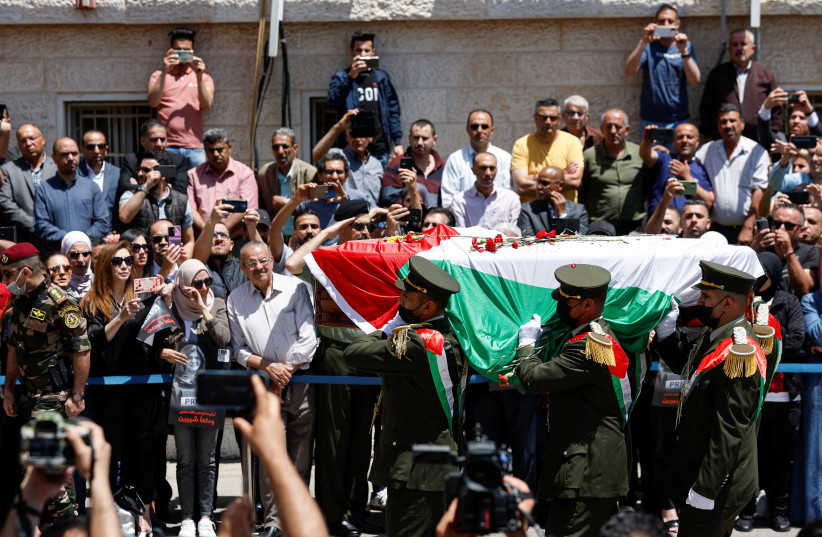Test results on the damaged bullet that killed Palestinian-American journalist Shireen Abu Akleh were inconclusive. But additional investigations showed it was likely she was accidentally killed by gunfire originating from an IDF position, the United States said Monday.
“Ballistic experts determined the bullet was badly damaged, which prevented a clear conclusion,” US State Department spokesman Ned Price said in an announcement he released in the midst of the 4th of July holiday.
The US Security Coordinator oversaw third-party ballistic tests on the bullet and had full access to both IDF and Palestinian Authority investigations into the events in Jenin that May 11 morning when Abu Akleh was killed, Price said.
“The USSC concluded that gunfire from IDF positions was likely responsible for the death of Shireen Abu Akleh,” he said, adding that “the USSC found no reason to believe that this was intentional.”
"The USSC concluded that gunfire from IDF positions was likely responsible for the death of Shireen Abu Akleh"
Ned Price, US State Department spokesman
“We will remain engaged with Israel and the Palestinian Authority on next steps and urge accountability,” Price added.

The American conclusions were published in advance of US President Joe Biden’s scheduled July 13 visit to Israel and the Palestinian territories.
A US official said Israelis and Palestinians had expressed frustration with its statement, which was issued simultaneously with a separate one from the IDF.
Israel was upset that the US held it “likely” responsible, but it kept the discord out of its public statements.
The PA was angry that the IDF was not charged with deliberately killing Abu Akleh. It rejected the claim that the bullet was damaged and said it planned to turn to the International Criminal Court.
“This [determination] is not true and we are surprised by what was stated in the [US] statement,” the Palestinian Public Prosecution said in a statement.
“The technical reports we have confirm that the condition of the projectile can be matched with the weapon used, in addition to the fact that the targeting of the martyr Abu Akleh, according to the evidence and conclusive evidence, was deliberate,” it emphasized.
The PA Foreign Ministry said it was “a miserable attempt to protect the criminals and murderers.”
Ballistics tests are performed on bullets to identify signature markings unique to specific firearms. Israel had said without the bullet, it was impossible to determine if Abu Akleh had been killed by an IDF soldier or a Palestinian gunman.
While Israel had hoped that a ballistic test would prove the IDF had not killed Abu Akleh, it had also wanted to test the bullet against firearms used by soldiers located within shooting range of Abu Akleh that morning.
A senior diplomatic source said not much more can be done to investigate Abu Akleh’s death because the bullet is in bad shape and as a result “we will probably remain with uncertainty.”
Official Israeli responses
Defense Minister Benny Gantz pledged to continue the investigation into her death.
“The defense establishment is committed to uncovering the truth,” he said. “Unfortunately, it is not possible to determine the source of the shooting, and as such, the investigation will continue.”
THE IDF said a determination could be made with respect to a criminal investigation only once such a probe was concluded.
“The defense establishment is committed to uncovering the truth. Unfortunately, it is not possible to determine the source of the shooting – and as such, the investigation will continue"
Defense Minister Gantz
Gantz said Abu Akleh was killed while covering a gun battle between soldiers and armed Palestinians.
“It is important to emphasize that during this operational event, like in many others, hundreds of bullets were fired at IDF troops, who responded with firepower of their own, only in the direction of the sources of the shooting,” he said.
“The first to bear responsibility in such events are the terrorists who operate from within population centers,” Gantz said.
Prime Minister Yair Lapid said even without the ballistic tests, “it can certainly be determined that there was no intention to harm her. Israel expresses regret over her death.

“In recent years, hundreds of journalists have been killed in battle zones around the world. It goes without saying that Israel is interested in protecting journalists and the freedom of the press anywhere and under any conditions.
“As prime minister of Israel, I give full and unequivocal backing to IDF soldiers who risk their lives to protect Israeli citizens from terrorism and work day and night for Israel’s security.”
The PA had held on to the bullet until Saturday because it had not trusted Israel to solely conduct the ballistics test. It agreed to hand it over to the US, which also had a vested interest in the results because of Abu Akleh’s American citizenship.
The bullet was tested in a forensic laboratory in Israel by Israeli experts, the IDF said, adding that the “USSC representatives were present throughout the entire process.”
“Despite these efforts, the physical condition of the bullet and the quality of the characteristics on it do not enable a ballistic examination to conclusively determine whether or not the bullet was fired from the weapon that was examined,” it said.
Shireen's family
The Abu Akleh family dismissed the US and IDF findings, stressing that it was an “extrajudicial killing” of a US citizen by a “foreign government”
“We are incredulous,” the family said, adding that the conclusions “were insulting to Shireen’s memory.”
In such cases, the FBI is typically called in, the family said, asking why that had not happened.
“The focus on the bullet has always been misplaced and was an attempt by the Israeli side to spin the narrative in its favor as if this was some kind of a police whodunit that could be solved by a CSI [crime-scene investigation]-style forensic test,” the family said.
A professional opinion
Lior Nadavi, an Israeli forensic ballistics professional, told reporters on a call organized by Media Central that while he could understand why the investigation could not determine who shot the bullet because of its condition, he found it hard to understand how the Americans determined that the shot was fired by Israeli troops.
“To put a whole case on one bullet is wrong from the investigative point of view,” he said. “You need to start with the crime-scene investigation, and many details are missing, at least for us in the public. For example, what was Shireen’s position at the moment she was hit: Was she facing Israeli soldiers? Was her back facing them or her side? She was standing next to a wall; are there any bullets that hit the wall? That can be checked, and the bullet that hit her could have been a ricochet, and then the whole story takes a turn.”
Nadavi, a former crime-scene investigator and firearms examiner for the Israel Police, said he also would like to see the autopsy report and understand the size of the bullet hole and if she was hit directly or from the side, as well as the X-ray photos of her body, and ascertain whether the bullet in the X-ray is the bullet that was shown in the media.
“They could have taken any bullet from the scene and said it came from the Israeli side,” Nadavi said, adding that “the bullet is supposed to break apart when it hits and cause greater damage. The fact that this didn’t happen means it could have hit something and then lowered its velocity... There are so many variables in this case that we just don’t know.”
